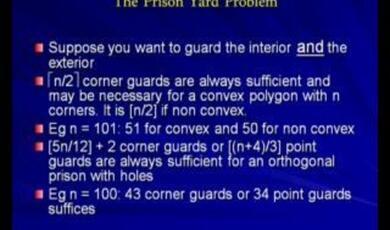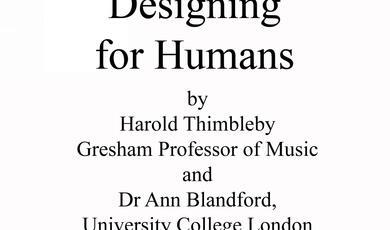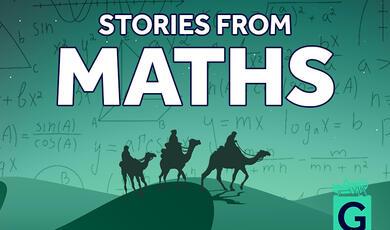The Surprising Uses of Conic Sections
Share
- Details
- Text
- Audio
- Downloads
- Extra Reading
Conic sections – the curves made by slicing through cones at various angles – were studied by the ancient Greeks, but because of their useful properties, have many real-world uses. Planets have elliptical orbits, projectiles move in parabolas, and cooling towers have hyperbolic cross-sections. But did you know that one of the most important curves in economics is a hyperbola? Or that ellipses are used to cure kidney stones?
Download Text
The Surprising Uses of Conic Sections
Professor Sarah Hart
25th April 2022
Conic sections – the curves made by slicing through cones at various angles – were first studied by the ancient Greeks. The ellipse, parabola, and hyperbola have many interesting properties and applications. Today we’ll explore some of these, and along the way will find out how ellipses can be used in medicine, how to make a parabola by paper-folding, and what the hyperbola has to do with economics.
Introduction
When we slice (or “take a section” of) the cone, if the plane is horizontal we get a circle (a special case of an ellipse). As we tilt the plane, we obtain ellipses, until we reach a point where the plane is parallel to the slope of the cone. At this precise angle, the resulting curve is a parabola. Increasing the angle of the plane results in the plane intersecting both halves of the cone, and we then get hyperbolas.
In this lecture we’re going to look at these three curves in turn, and I’ll show you three real-world applications of each one.
The Ellipse
One way to define an ellipse is the following. Given two fixed points F and F’, and fixed distance r , the corresponding ellipse is the set of points P for which FP+PF'=r . This definition gives a nice way to draw an ellipse. You put two pins in a piece of paper, and place a loop of string round them. Then place a pencil against the string and draw the curve formed as the string is kept taut. If the pins are at points F and F’ , and our pencil happens to be at point P , then the total length of the string, which stays constant of course, is |FP| +|PF’| +|F’F| . Since |F’F| is also fixed, what we see is that in this curve the sum of the distances from the two fixed points, which are called foci, is always constant. And so we really do get an ellipse.
It's not obvious that the curve we get when we slice through a cone is an ellipse, with our choice of definition, but it does turn out to be the case. The same is true of the parabola and the hyperbola. These things can be proved with algebra, or using a neat argument nesting spheres between the cone and the intersecting plane, named “Dandelin spheres” after the French mathematician Germinal Pierre Dandelin.
Application 1: Elliptical Gears
In most applications in a gear system we want everything moving at constant speed (though gears of different sizes will move at different constant speeds). However, there are some cases where we want to introduce variations in speed. An example of this might be a production line in a factory where you want items to move quickly between the places where something is being done to them, and then slowly during those points. If you have two elliptical gears of the same size, each fixed with an axle at one focus, and you ensure that those fixed foci are distance r apart, and that the other pair of foci are distance r apart (by means of a rod joining them, for instance), then when you rotate the input gear about its fixed focus, it will cause the output gear to rotate, and the gears will remain touching at all times. But because the distance between the focus and the edge of the moving gear is changing, the speed of the output gear will change even when the input gear is being rotated at constant speed.
One property of the ellipse is really useful and it gives us our second application. If you draw a tangent to the ellipse at a point P , then the angle between FP and the tangent equals the angle between PF’ and the tangent.
Proof
Here’s a proof of this, which we won’t do in the lecture but I thought would be nice to include in the transcript. Let P be a point on the ellipse with foci F and F’ . The first step is to construct a line L which is going to turn out to be a tangent. To do this, extend the line F'P to the point X such that |PX| = |PF|, and then draw the perpendicular bisector of XF . This is our line L . It consists of the set of points equidistant from X and F , and this means in particular that P lies on L . A tangent is a line that meets a curve in exactly one point. So to prove L is the tangent at P , we must show that no other point on L can lie on the ellipse. So, let Q be any point on L other than P . Since L is the perpendicular bisector of XF , we know |QF| = |QX| . Because F'QX is a triangle (since Q is different from P ), we know that |F'Q| + |QX| > |F'X| . But |QX| = |QF| and |F'X| = |F'P| + |PX| = |F'P| + |PF| , because, remember, |PX| = |PF| . But this means that |F'Q| + |QF| > |F'P| + |PF| . But the ellipse consists precisely of those points R for which |F’R| +|RF| is constant. So Q cannot lie on the ellipse. This means that L meets the ellipse at P and only at P . So it’s tangent to the ellipse at P . The angles θ2 and θ3 are corresponding angles in two congruent right-angled triangles. Thus, θ2=θ3 . Also, θ1 and θ3 are vertically opposite angles, so again are equal. Hence θ1=θ2 . In other words, the angle between the tangent and FP is equal to the angle between the tangent and F'P .
QED
The equal angle property means that if we had an elliptical mirror, then any light beam that passed through one focus would reflect to pass through the other focus. By the same token, an elliptical pool table with a pocket at one focus would have the property that if we hit the ball in any direction from the other focus, it would bounce off the cushion and go into the pocket. People have built such things for fun.
Application 2: Lithotripsy
A genuine application of the equal angle property of ellipses is in medicine, with a machine called a lithotripter, which treats kidney stones. You could do an operation to get them out, but that’s risky and invasive. One alternative is to break them up in situ by bombarding them with high energy sound waves. The tiny pieces can then pass harmlessly out of your body. Of course, you don’t want to damage the healthy tissue, so you need a way to focus the waves just on the stones. The solution is to have the waves emitted from a source at one focus of an ellipse, and then have an elliptical reflector, the waves are reflected and converge at the other focus, which is where the kidney stone is.
If we take a point P on the ellipse, and extend the line from F’ to P out to a point X such that |PX| = |PF| , then X is a distance of |F’P| + |PF| from F’ , and this is constant, and independent of the choice of P . Thus these points X lie on a circle centre F’ . If we set |F’P| + |PF| = r , then the points X form a circle, centre F’ and radius r . There’s something else we can say. The point P is equidistant from X and F , so it lies on the perpendicular bisector of the line XF . That is, if we had a piece of paper and folded it to join X and F , then P would lie on the fold line. This gives us another way to create an ellipse – by folding circles. Take a circular piece of paper, and mark a point S a little way in from the edge. Now repeatedly fold in from the edge of the paper to just touch S . Crease the fold, unfold and then repeat at a different point on the circumference. If you work your way round the whole circle, you'll see an ellipse forming. One focus is S , and the other focus is the centre of the circle.
Application 3: Astronomy
Another place where ellipses play an important role is astronomy – the planets have elliptical orbits around the sun, which is at one focus. That's why we used S for our notation just now – it’s for Sun (or Solus, if you write in Latin like Newton). Many years ago when we had pound notes instead of pound coins, they showed Isaac Newton and a picture of the solar system with planets orbiting around the sun in ellipses. Unfortunately, the picture was wrong, because it showed the sun at the centre of the ellipse, not at a focus.
We can use the definition of the ellipse that FP+PF’ is constant to find the equation of an ellipse. If we put the foci equally spaced on the x-axis either side of the origin, then the ellipse has equation x2a2+y2b2=1 , for appropriate a and b with a≥b . (If a<b we still get an ellipse but its foci are on the y -axis. By varying a and b we can vary the size and shape of the ellipse. In the diagram below, the foci are at (c,0) and (-c,0) , and it can be shown that c2=a2-b2 .
The two things that distinguish ellipses from each other are their size, and their degree of “roundness”: are they close to being a circle, or are they very long and narrow? This latter property can be described precisely in terms of a quantity referred to as the eccentricity of an ellipse.
Take an ellipse with foci F and F' . It consists of the points P for which |PF| + |PF'| = r , for some constant r . The eccentricity e of the ellipse is defined to be |FF'|r . On the graph it’s ca . The closer the value of e gets to 0, the more the ellipse resembles a circle; a circle can be thought of as an ellipse with eccentricity 0. As we saw with the “folding circles” construction, the ellipse is contained in a circle centre F’ and radius r . Since the line F'F is part of a radius, we have 0≤e<1 . Now pick r>1 and fix FF’= r-1 . Then e=r-1r=1-1r. If we let r get larger and larger, in the limit we get “eccentricity 1”, which would involve a “circle of infinite radius”. This gives rise to a parabola, and that’s what we’ll look at next.
The Parabola
The parabola is the conic section that results if we cut a cone with a plane that is parallel to the sloped sides of the cone. Thinking about how we made the ellipse by folding a circle, remember that we marked a point F in the circle, and folded points X on the circumference to F , and then for each point P on the ellipse, we had |PF|=|PX| . The other focus was the centre of the circle. Now, imagine making the circle larger and larger. In the limit, the centre of the circle – the other focus – is at infinity; the curve we produce is a parabola, and the circle becomes a straight line. But we still have |PF| =|PX| , so the distance from the focus to each point P on the parabola equals the distance from P to the straight line (called the “directrix”).
We can take this as the definition: a parabola is a set of points in the plane whose distance from some fixed point F (the focus) is equal to their distance from some fixed line L (the directrix) that does not contain F . We can therefore make a parabola by folding, not a circle, but a normal piece of paper. Just mark a point F about an inch from the long left-hand side. Then repeatedly fold the long edge onto the point, creasing the fold and then unfolding.
Suppose the directrix is x=-a and the focus is (a,0) . Let P=(x,y) be a point on the parabola. The distance of P from the directrix is x+a . We use Pythagoras’s Theorem to find the distance from the focus. We get x-a2+y2 . These two must be equal. That is, x+a2=x-a2+y2 . Multiplying out gives x2+2ax+a2=x2-2ax+a2+y2 , and thus y2=4ax . If we choose a=14 , then the equation is y2=x . (We could flip the axes and retrieve the well-known y=x2 for a “vertical” parabola with horizontal directrix.)
It can be shown that the parabola has an equal angle property similar to the ellipse. As we’ve said, essentially a parabola is an ellipse with one focus at infinity. Let L be the directrix, and let’s orient the parabola so that L is vertical, and let F be the focus. If P is a point on the parabola, and we draw a tangent to the parabola at P , then the angle between the tangent and the horizontal line “from infinity” through P is equal to the angle between the tangent and the line PF .
Application 1: Telescopes and Satellite Dishes
The equal angle property of parabolas means if parallel rays of light all perpendicular to the directrix are reflected off the parabola then the reflected beams will pass through the focus. Telescopes exploit this property by using a parabolic mirror to focus the (approximately) parallel beams of light from a distant star. Parabolic antennas do the same thing for radio waves, and that’s why we see them in satellite dishes.
A parabolic mirror can be used to focus light from the sun to a single point, potentially generating enough heat to set fire to a flammable object placed at its focus – and this is where we encounter the Archimedes Death Ray! Archimedes was from Syracuse, which was threatened with invasion by the Romans. Historians recount that one night the fleet was spotted coming into the harbour. The story then goes that this is when Archimedes deployed his genius weapon – parabolic reflectors that focused the rays of the sun onto the ships, causing them to burst into flames. It’s an excellent story, but one or two tiny problems make it likely that it’s not true. Firstly, it’s pretty hard using the technology available to make a reflective enough surface to generate the required amount of heat for combustion. Secondly, no contemporary reports of the invasion say that this happened (the first to mention it was Galen, 350 years later). Thirdly if it was so great why wasn’t it ever used again? And finally, how does the story begin? At night!
Application 2: Lights
We can use the reflector property in reverse. A parabolic mirror will reflect light from a bulb placed at its focus to give a parallel beam of light. We can see this in torches and also the headlamps of vintage cars.
We saw that gravity causes the planets to have elliptical orbits. But when the two bodies involved have extremely different masses, such as a pebble and the entire planet Earth, and the centre of one is vastly far away compared to the distance between them, then the motion is, to a very good approximation, parabolic. We can actually see this using the equations of motion that you might have seen if you studied physics at school. If an object is moving with constant speed v in a given direction, then the displacement after time t is just vt (distance equals speed times time). If an object at rest starts accelerating at a constant acceleration a in a given direction, then at time t its displacement is 12at2 . Now let’s apply this to the situation of a pebble being thrown horizontally. It has a constant horizontal speed, let’s pick a not-very-random value of v=1 metre per second. Its initial vertical speed is zero, and it will accelerate vertically downwards due to gravity, at approximately g=10 metres per second squared. So at time t , if we say it starts at the point (0,0) , it will be at position (x,y) , where x=vt=t , and y=-12gt2=-5t2 and so y=-5x2 . This is just an upside-down parabola (or half of one).
Application 3: Water features
The same mathematics applies to a jet of water flowing horizontally out of a pipe (or indeed a waterfall): it creates a beautiful half-parabola. We can also show that if you instead aim your jet of water upwards at an angle, you still get a parabolic trajectory. If you know the equations you can work out exactly where the water will land, and use this to create pleasing effects, for example a series of fountains where the water comes out in bursts, giving the appearance of jets of water that jump from one place to another.
The Hyperbola
The final type of conic section is the hyperbola. This is what you get when you slice through the cone at a steep enough angle (steeper than the angle of the cone itself) so that you hit both parts of the cone. You may well see hyperbolas every evening because of this. If you have a lamp with a cylindrical lampshade, then the light from the bulb that actually escapes from the lampshade forms a cone. That cone of light intersects the vertical plane of the wall forming a beautiful hyperbolic shadow.
It’s possible to define a hyperbola with a distance rule, just like the ellipse and the parabola. For the ellipse, the sum of the distances from the foci was fixed. For the hyperbola, it’s the difference between these distances that’s a constant.
Application 1: Telescopes (again)
A hyperbolic mirror has the property that a beam of light directed towards (but on the other side of the mirror from) one focus is reflected to pass through the other focus. In a Cassegrain telescope light rays hit a parabolic mirror, and reflect towards the focus, before which they hit a hyperbolic mirror with that same focus. They are then reflected towards the other focus of the hyperbola, where they can be viewed. This makes the telescope more compact, as the focus of a parabola can be quite a long way from the mirror. The same technique is often also used in large satellite dishes.
It can be shown that the graph y=mx , where m is any fixed constant you like, is a hyperbola. The ancient Greek mathematician Manaechmus, who is believed to be the first person to study conics, was doing so to try and solve the problem of doubling the cube. That is, given a cube, to give a geometric construction of one that’s exactly double the volume. It’s not possible if you constrain yourself to “straightedge and compass” constructions, but Menaechmus showed that using the intersections of certain conics does give a way to double the cube. I’m going to show you why that might be, but in a completely anachronistic way – this is not the way Menaechmus would have argued, because algebra didn’t yet exist. Given a cube of volume v , think about where the parabola y=x2 meets the hyperbola y=2vx . It will be where x2=2vx , that is, where x3=2v. To ‘find’ this x , draw the curves and find the point of intersection. Now you can construct a cube of side x . Its volume is x3 , which is 2v , and we’ve doubled the cube!
Application 2: Cooling Towers
If you take a hyperbola and spin it around its axis you create a hyperboloid – typically seen as the shape of cooling towers. Water is often used as a coolant in industry, but of course that warms the water up, and then the water needs to be cooled down before it can be re-used. It is pumped into the tower part-way up its height, then passes down onto what’s called an exchange surface. Some of it evaporates, creating a vacuum which sucks air into the bottom of the tower. That air cools the remaining water, and it drips down through the exchange surface into a reservoir at the bottom of the tower. Only about 2% of the water escapes as steam, so this process is very efficient. The hyperboloid shape was first used in 1918, after being patented by Dutch engineers Frederick Van Iterson and Gerard Kuypers[1]. It is very strong, uses less material than a cylinder of the same height and base, and the shape also helps the air flow efficiently.
The hyperboloid also has the property that although it is a curved shape, it can actually be created with straight lines, which is a useful quality for construction, because they can be made with a lattice of straight beams rather than curved beams. Such things are known as ruled surfaces. There are also “double ruled surfaces” like the hyperbolic paraboloid “pringle” shape.
There’s another fun way to make a hyperbola, and that’s what I’ve christened “tidying rectangles”. Pick a number, say 12, and work out all the rectangles that have area 12, such as 12×1 , 3×4 , or 6×2 . Then organize them nicely by putting one of their corners at the origin, with the two edges sitting on the two axes. You don’t have to stop at whole numbers, you can add in 8×1.5 , and so on. If you keep placing rectangles like this, you start to build up a shape whose boundary is a curve. But which curve? Well, it’s the curve that passes through the top right-hand corner of each rectangle. And if the rectangle has width x and height y , then that will be the point (x,y) . But the area of the rectangle is 12, and so xy=12 . So the curve we have made is y=12x , a hyperbola.
Application 3: The Demand Curve
The law of demand says that demand for goods decreases when the price goes up, as they become less affordable, and increases if the price drops. There are one or two exceptions. For some luxury goods, raising the price gives them even more cachet and demand goes up. These are called Veblen goods. At the other extreme, a very low price-tag signals that the item must be of poor quality. Raising the price can then increase demand. However, in most cases the law of demand holds, that there is an inverse relationship between price and demand. The demand curve for a product plots quantity demanded (i.e. how many you can sell) against price charged. Different goods have different demand curves, but one interesting case is what you might call the “kid’s budget” model. A kid given 50p to spend on sweets is likely going to spend it all. If sweets cost 5p each, you buy 10 sweets. If they cost 2p each, you buy 25 sweets. In this case, the total expenditure is fixed. If we think about a particular price point and quantity demanded, we can put a rectangle under the demand curve, and its area will be the price multiplied by the amount purchased, that is, the total spend. In our pocket money example, we always spend all the money. So the area of all these rectangles is the same (in our example it’s 50). That means we get the “tidying rectangles” curve – a hyperbola. There are lots of cases where the demand curve would be a hyperbola. For instance an adult might have something like this with an annual budget for holidays or meals out.
It’s wonderful to think that conic sections, first studied over two thousand years ago, have such a diverse range of interesting applications. Even if there were no applications at all, they are of course still interesting and beautiful and worthy of study. We can’t know which bits of pure mathematics are going to have applications, but conics are just one instance of a topic that does. They weren’t studied with economics, medicine or astronomy in mind, and yet they have uses in all these areas – amazing!
© Professor Sarah Hart 2022
Image Credits
Unless otherwise specified, the technical diagrams are drawn by me and are ©Sarah Hart, and the photos and videos are either taken/made by me or are public domain images.
- The three conics, by Pbroks13, CC BY 3.0, via Wikimedia Commons https://commons.wikimedia.org/wiki/File:Conic_sections_with_plane.svg
- Lithotripsy diagram from https://medical-dictionary.thefreedictionary.com/lithotripters
- Newton £1 note image from https://www.bankofengland.co.uk/banknotes/withdrawn-banknotes
- Cooling towers image, zootalures (Owen Cliffe), CC BY-SA 3.0, via Wikimedia Commons
https://commons.wikimedia.org/wiki/File:Didcot_power_station_cooling_tower_zootalures.jpg
- Allan H Brooks / New Control Tower Newcastle Airport / Image use permitted under CC BY-SA 2.0 https://commons.wikimedia.org/wiki/File:Newcastle_International_Airport_Control_Tower.jpg
[1] See https://www.engineeringclicks.com/cooling-tower/ for a fuller explanation of how a cooling tower works.
Part of:
This event was on Mon, 25 Apr 2022
Support Gresham
Gresham College has offered an outstanding education to the public free of charge for over 400 years. Today, Gresham College plays an important role in fostering a love of learning and a greater understanding of ourselves and the world around us. Your donation will help to widen our reach and to broaden our audience, allowing more people to benefit from a high-quality education from some of the brightest minds.


 Login
Login







